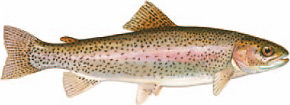 Scientific Name
Scientific Name
Oncorhynchus mykiss
Other Common Names
rainbow
Identification
The variety of rainbows has resulted in a variety of colors, hues and markings. Normally the back is olive-green with a silvery cast on its sides fading to a silvery-white belly. A pinkish or light rosy red band extends from its cheek to near its tail. Normally, they are well spotted with black spots, but vary from large spots to tiny specks to no markings at all.
Best Fishing
Well established in streams of the southwestern region of the state and are found in a myriad of mountain streams in western Virginia. Lakes: Moomaw. Rivers and Streams: Smith River, Elk Creek, Dan River, Potts Creek, Cripple Creek, Roanoke River, Little Reed Island Creek, Jackson River, Crooked Creek and Big Tumbling Creek, and many others on both sides of the Blue Ridge. Some good wild streams are Whitetop Laurel, Fox Creek, and the South Fork Holston River.
Fishing Techniques
Hits dry flies, wet flies, streamers, nymphs, small spinners and spinner-bucktails, spoons, as well as worms, live nymphs, minnows and salmon eggs. Hatchery trout readily take kernel corn and colored marshmallows. Berkeley Power Baits that give off a scent and can be shaped on the hook are used extensively by anglers.
Feeding Habits
Eats a variety of aquatic and terrestrial life. Large rainbows will eat small fish, but their main diet is invertebrates. In very cold climates, they ingest minute aquatic organisms through fine gill-rakers.
Habitat
Originally native to the western slope of the Rockies. Successfully introduced into eastern streams including those in Virginia. Most Virginia rainbows are in fast flowing, larger streams and constitute the backbone of the Department’s stocking program.
Spawning Habits
The majority of rainbows in Virginia are stocked fish. There are a good number of wild fish in Mount Rogers Area streams. When spawning occurs it is at the lower ends of pools or in riffles where the female digs out a spawning bed or “redd.” Rainbows in their natural state spawn in spring.

